Is Surgery Absolutely Necessary In A Clean Tibia Fracture Back Leg Of A Dog
Domestic dog Fractured Tibia (shinbone)
Some canine fractures are so severe they require the expertise of a specialist in os surgery. Nosotros take a specialist in os surgery that volition come to our hospital and perform the repair in dogs, cats, and other species similar this rabbit. This has several advantages, not the to the lowest degree of which information technology costs less than if we refer the repair to a surgical specialist at a referral infirmary.
This is a severe fracture, and a domestic dog with this trouble is very painful and tin can go into shock. This is a medical emergency requiring immediate veterinary intendance. The Long Beach Animal Infirmary, staffed with emergency vets, is available until the evenings 7 days per week to aid if your pet is having whatever problems, especially daze, pain, breathing difficult, or bleeding.
Recall of us as your Long Embankment Brute Emergency Centre to help when you demand usa for everything from pocket-size problems to major a major emergency. Nosotros serve all of Los Angeles and Orange county with our Animal Emergency Center Long Embankment, and are hands attainable to most everyone in southern California via Pacific Coast Hwy or the 405 throughway.
If y'all take an emergency that can be taken care of by u.s. at the Beast Emergency Hospital Long Embankment e'er call u.s. first (562-434-9966) before coming. This way our veterinarians can suggest y'all on what to practise at abode then that our staff and doc can prepare for your inflow. To learn more please read our Emergency Services page.
These pictures prove the repair of Dakota, a Labrador who fractured his tibia (shinbone) by playing.

Blazon of Fracture
This fracture is chosen a spiral fracture due to the winding nature of the scissure. The fracture is much more severe than is apparent on this x-ray. What is not apparent on the ten-ray are the numerous bone fragments that were institute surgically.
This is a astringent fracture, then nosotros have our orthopedic specialist Dr. Paul Cechner perform the surgery. He has decades of experience and the latest loftier tech equipment to practise it correct.

Graphic surgery photos on this page
Surgery Preparation
Our patient is given a thorough pre-anesthetic examination within 24 hours of his surgery.
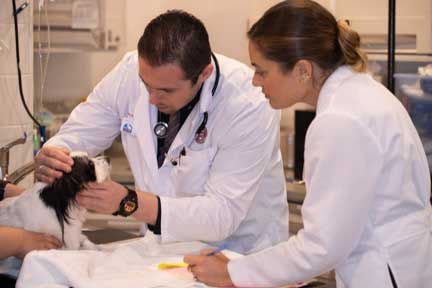
One of our student externs learning how to do a pre-coldhearted physical exam from Dr. Forest
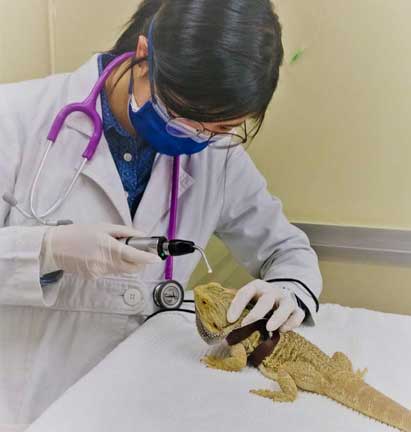
Fifty-fifty reptiles get get a pre-anesthetic exam
After the exam there are routine pre-coldhearted tests nosotros perform. The three most of import ones are a blood console, radiographs, and a pre-anesthetic EKG (ECG).
Pre-surgical Preparation
Blood Console
A dog that has trauma hard enough to break a leg might have some internal injuries that are non apparent externally when we perform a physical exam. I exam to assist united states look for whatever problems is a blood panel.
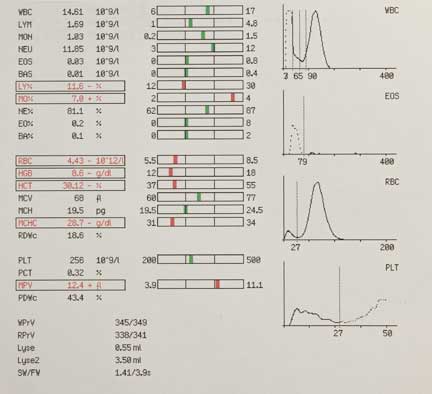
This is one page or our multiple page in-house blood panel. This pet is bloodless, so nosotros will be on the alarm for internal bleeding
Radiology
This is especially important on a trauma instance like this. Our patients do not talk to usa, and they accept high pain thresholds compared to u.s. humanoids, so they don't always prove symptoms to permit us know something else is a problem besides the fracture. Nosotros do not desire any surprises on the day of surgery.
When nosotros take a pre-anesthetic radiograph we are specifically looking for fractured ribs, pneumothorax, and a diaphragmatic hernia. This is important to minimize the risk of anesthesia, and to make sure all problems are identified and corrected.

This is a normal chest radiograph on a dog
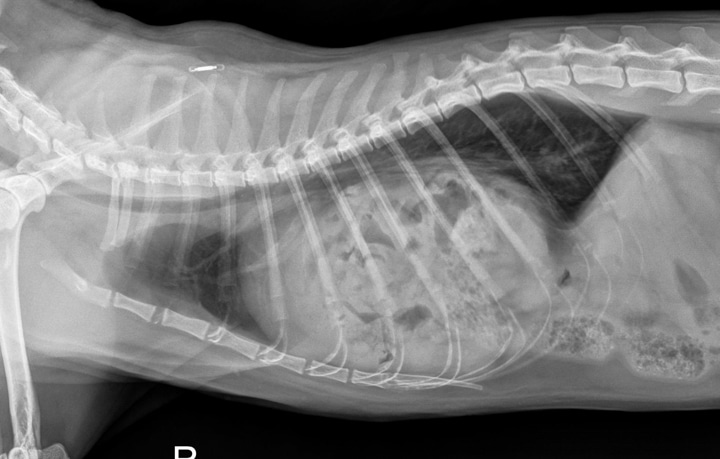
This is what a diaphragmatic hernia looks like. Tin can you see it compared to the radiograph to a higher place?
Learn much more most radiology from our Learn to Read an Ten-Ray folio.
Pre-Anesthetic ECG
Animals with cleaved basic from being hit by a car (HBC) tin have trauma to the middle that is non apparent when we listen with the stethoscope. For this reason we perform an electrocardiogram but prior to surgery.
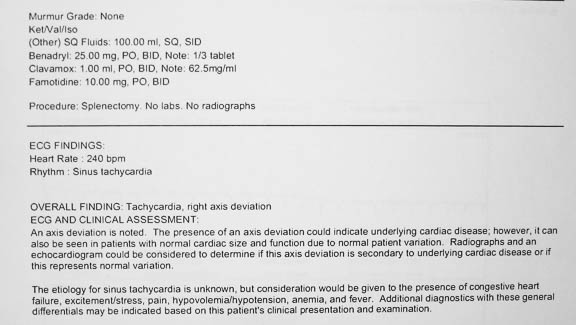
This one has a potential problem that needs to exist addressed
In orthopedic surgery like this one we are inserting wires, bone plates, and screws. They will stay in long-term unless there is a trouble with infection or rejection. Considering of this sterility and aseptic technique is crucial, and information technology starts with our surgeon scrubbing his hands.

He thoroughly scrubs from his fingernails to his elbows

As soon as our surgeon is gloved and gowned he goes go right into the surgery suite to get the instruments ready. We do non want our patient waiting for our surgeon, nosotros want the surgeon waiting for the patient.
Anesthesia
Once we have analyzed our pre-coldhearted exam and tests we volition keep to anesthetize our patient. They are given pre-anesthetic tranquilizers and hurting medication to calm them down. Next they are given intravenous fluids.
Our Anesthesia Page has much more information on this.
Injectable Anesthesia
Injectable anesthetics are used for many purposes. 1 of their principal uses is to sedate pets before giving the actual anesthesia (called pre-coldhearted). In sedating ahead of time nosotros dramatically minimize anxiety, crusade a smoother recovery, and minimize how much coldhearted nosotros demand to administrate during the actual procedure. In addition, some injectable anesthetics minimize airsickness, a mutual problem when waking upward from anesthesia.

Injectable anesthesia is given intravenously, and rapidly induces relaxation and so that we can put in a breathing tube (also called an endotracheal tube or ET tube)
Endotracheal Tube
Oxygen is delivered to the lungs past the ET tube in its windpipe. Information technology is the preferred method to administer oxygen because it is very efficient, volition prevent any vomitus from entering the trachea (airsickness rarely happens because of fasting and pre-anesthetic sedation), and allows usa to gently inflate the lungs during surgery then that they piece of work at maximum efficiency.
Besides oxygen, the anesthetic gas (Isoflurane) is also administered through the endotracheal tube. Medications tin fifty-fifty be administered via this special tube.

The endotracheal (ET) tube is placed directly into the windpipe
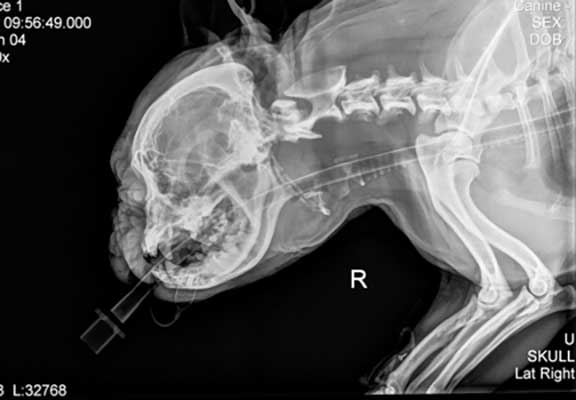
This x-ray shows the breathing tube as it passes over the natural language and down the trachea (windpipe)
Nosotros can easily breathe for your pet and inflate your pet's lungs by gently squeezing the bag connected to the tube, monitoring the corporeality of pressure we are exerting with a gauge on the coldhearted automobile. Each size and species of pet requires a different sized endotracheal tube.
The tube is non removed from your pet until information technology is literally waking upward. This ensures that the swallowing reflex is present, and your pet is now safely able to exhale on its ain.
Gas Anesthesia
The mainstay for general anesthesia is gas anesthesia because information technology is very condom and highly controllable. We use a safe and effective gas anesthesia called Isoflurane. It is so safe it tin be used in creatures as minor equally tiny birds. As presently as this patient is intubated it is put on gas anesthesia.
An musical instrument chosen a precision vaporizer is used to deliver the Isoflurane anesthetic gas inside the oxygen. Information technology is a very precise musical instrument allowing usa to make fine adjustments in anesthetic level. Without this vaporizer nosotros would non have the wide safety margin that we currently enjoy.

We can precisely and hands change the level of anesthesia during the procedure equally needs change
For most surgeries we administer the anesthetic at a setting of 1-3 %. This modest per centum of anesthetic, added to the 100% oxygen the pet is breathing, is all that is needed to reach complete surgical anesthesia. Before the surgical process is finished the coldhearted is lowered earlier it is turned off completely. Every bit the surgeon is finishing the procedure your pet is in the start stages of waking up. This decreases anesthetic fourth dimension, some other way we minimize coldhearted risk.
Oxygen
All pets put under gas anesthesia are given 100% oxygen from the moment they are anesthetized until they wake up, dramatically increasing the safety of the procedure.

Nosotros have a special machine in surgery that generates 100% oxygen
As a backup, oxygen is stored in large tanks under high pressure. The oxygen in these tanks is delivered to the anesthetic machine via special piping throughout the hospital. This allows united states of america to take coldhearted machines in several hospital locations.
Our patient is anesthetized and the leg is shaved outside of our surgery room. We do all of this outside of the surgery room to keep it equally clean and sterile as possible.
Monitoring Anesthesia
Our surgeon is i of the all-time monitors, because he is literally visualizing the blood in the circulatory system. Any modify in the claret is readily noticed because pets that are breathing 100% oxygen should have vivid ruddy blood.
We use a sophisticated monitor to go along track of important physiologic parameters during surgery
Even with all of that high tech monitoring equipment we still stay easily-on during the whole procedure

We keep detailed records of fluid rate rates, anesthetic and oxygen levels, and physiologic parameters, during the surgery
We have a very detailed page that shows you the wide diverseness of animals we anesthetize. Click here to learn much more almost anesthesia.
Graphic surgery photos to follow
Surgery
The following area contains graphic pictures of an actual surgical process performed at the hospital. The surgery takes two hours, the following photos are just a summary of what it is similar to fix a bad fracture on a large and active dog. We need to put them back together properly or the fracture will non heal.
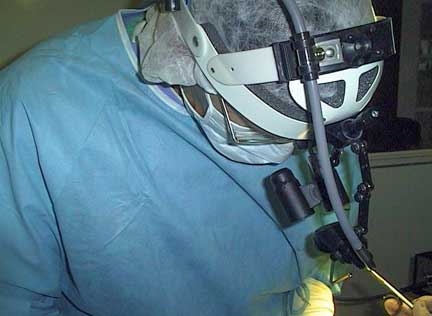
Our surgeon needs to use specialized equipment if he is to put this bone back together so that Dakota tin can return to normal function. In this picture he is using magnifying glasses and special lighting. In addition, he has orthopedic instruments and equipment without which he would never be able to repair such a severe fracture.
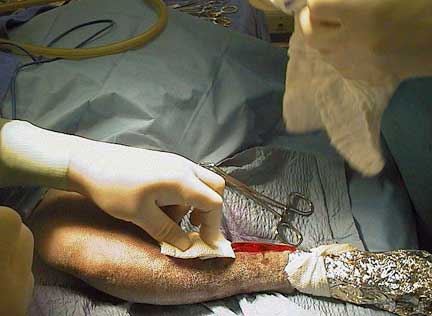
Bone infections tin can be serious so significant fourth dimension is spent in sterile preparation. When Dakota has been anesthetized, and fairly prepared, an incision is made on the within of his leg. This area has minimal muscle over it and gives expert exposure to the fracture site.
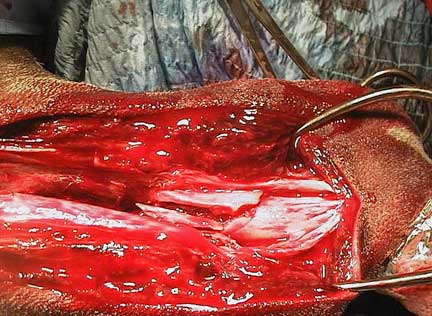
Later on advisedly dissecting through muscle tissue over the os the fracture is exposed
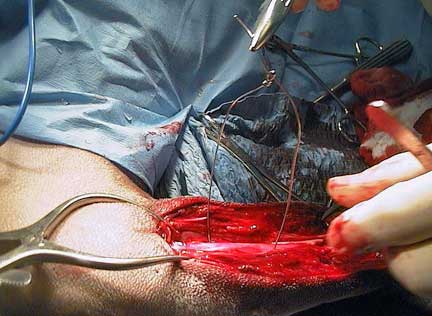
Once the bone fragments are isolated our surgeon uses special wires called cerclage wires to begin the process of holding the fracture segments in identify. It is a tedious procedure that takes upwardly a significant amount of the surgery.
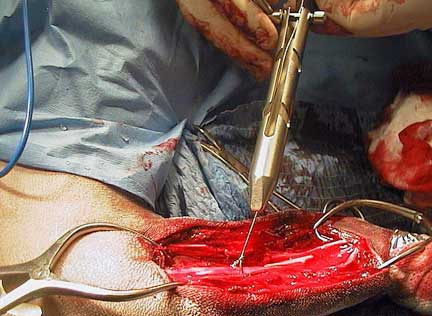
The wire is tightened down with a special instrument that gives just the correct amount of tension. As well little tension and the wire is useless, besides much and the bone fractures even more.

At this point ii cerclage wires have been applied to the fractures at the top, with new ones being applied to the fractures at the bottom
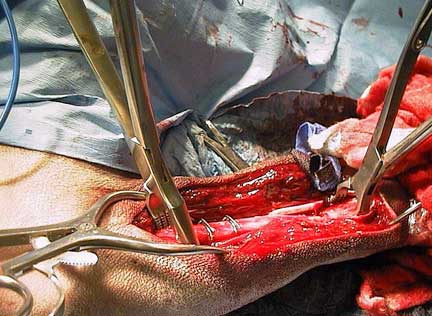
Eventually 6 cerclage wires are practical to marshal the bone fragments. Fifty-fifty though these wires are strong the bone will not stay in place and heal with just these wires. A bone plate is needed for most of the stability.
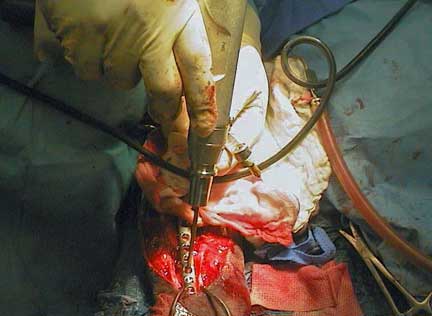
Later on the bone plate is measured and aptitude to the specific shape of this tibia, holes are drilled into the bone with a special air powered drill. They have to be drilled to the proper depth and angle or the bone will fracture more or the plate will fail.
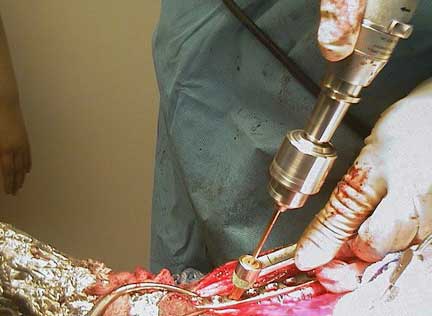
A special tap is used for proper placement
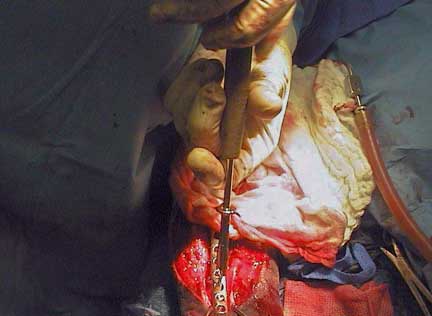
Drilling the holes is the showtime stride in the awarding of the plate. The depth of the holes is measured, and specific screws are used. Some screws compress the plate to the bone, others hold the plate in place.
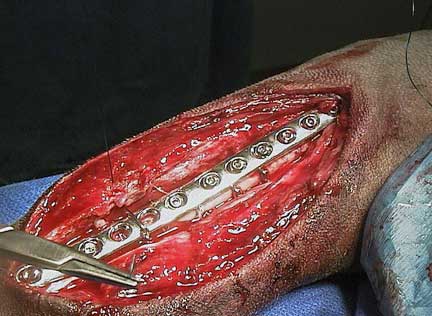
Two hours from the start of the surgery the plate has finally been applied. Nosotros will non remove information technology unless there is a post operative complication.
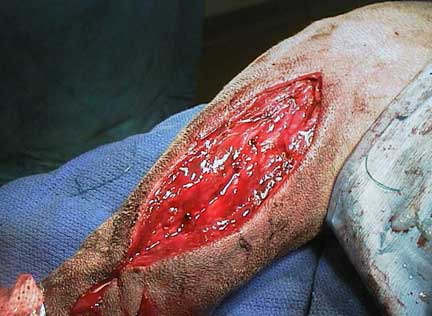
The musculus is sutured to preserve its part and to embrace the plate. These sutures will slowly dissolve over several months.
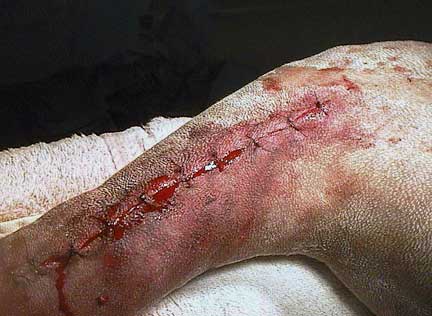
The peel sutures will stay in for 2 weeks. At this point in the surgery Dakota is given an antibiotic injection along with a pain injection. After one nights rest in the infirmary he volition go home. He volition need to be bars for one month for healing to progress.

Before Dakota is fully awake from anesthesia an x-ray is taken to appraise the surgery. The bend to the plate can be seen, forth with the cerclage wires and the different lengths of the various screws. The fractured fibula (arrow) will heal past itself.
In one case our surgeon is satisfied that everything is in society Dakota is given a pain injection and awakened from anesthesia. He will spend the night with us then that he can residual and so we tin monitor his recovery. He will demand to rest at dwelling house for several months before the healing is complete. We volition non take the plate out unless complications arise.

Share This Post
Source: https://lbah.com/canine/canine-fractured-tibia-shinbone/
Posted by: albrechtfait1939.blogspot.com


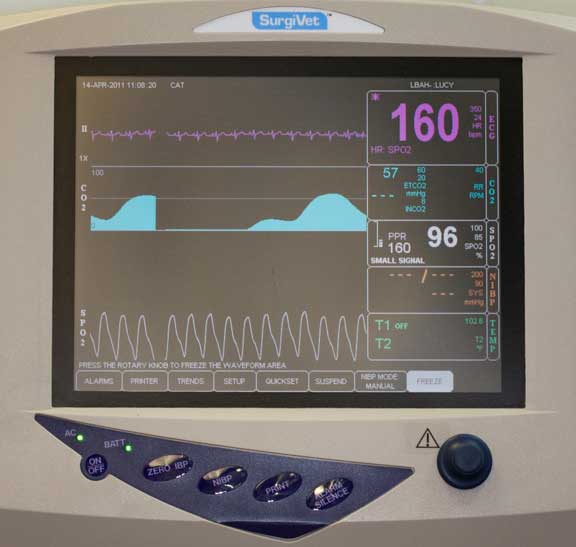
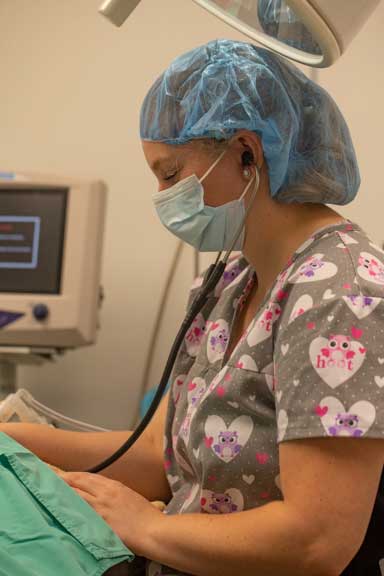

0 Response to "Is Surgery Absolutely Necessary In A Clean Tibia Fracture Back Leg Of A Dog"
Post a Comment